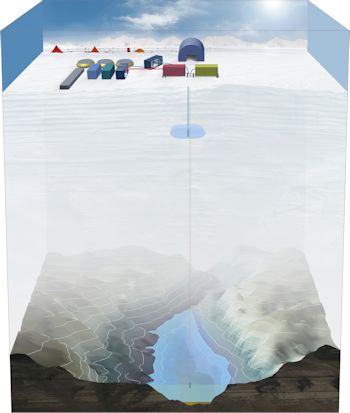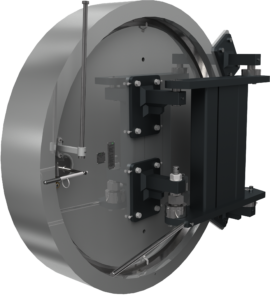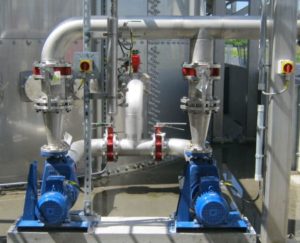Antarctic Expedition for Cat Pumps
An ambitious scientific mission to collect water and sediment samples from Lake Ellsworth, some 3km beneath solid ice in Antarctica, is using positive displacement triplex pump technology to provide high pressure hot water for an innovative borehole drilling system.

Graphic through ice to lake Ellsworth. Titanium probe will be lowered into the lake. (Image: Cat Pumps)
The British Antarctic Survey’s Lake Ellsworth Programme, which has been in planning for almost 15 years, will start drilling this December and over a period of three days will sink a 360mm diameter borehole through the solid ice. Key to the success of continuous drilling through ice at temperatures below -20ºC is a constant supply of water at 90ºC pumped at a pressure of 2,000psi using four pumps manufactured by Cat Pumps.
Accessing Lake Ellsworth is a unique logistical and engineering challenge. Located on the West Antarctic Ice Sheet, it is one of the most remote and hostile environments on earth, with ambient temperatures typically going below -35ºC. In October 2011, a four-man advance party prepared the way for the ‘deep field’ research mission, transporting 70 tonnes of equipment almost 16,000km from the UK to a location 1.7km from the drilling the site(Fig.1). The ‘Advance Party’ team paved the way for this mission by transporting the drilling equipment more than 250 km through the Ellsworth Mountain range, over deep-snow terrain and crevasses to the Lake Ellsworth drilling site. The final leg of this journey was the most challenging and required powerful tractors to tow heavy containers of equipment on sledges and skis, forming a ‘tractor-train’. Several days were then spent ‘wintering’ the equipment to protect it from the environment until the research team commence work in December this year (Fig.2).
Lake Ellsworth will be the first of Antarctica’s 400 known sub glacial lakes to be measured and sampled directly through the design and manufacture of space industry standard ‘clean technology’. The engineering challenge has been to design and build a water sampling probe, a sediment sampling corer and a hot water drill to create a borehole through 3 km of solid ice. There has also been the added challenge of ensuring that none of this equipment contaminates the lake environment. The most effective way to obtain rapid, clean access to Lake Ellsworth is to use hot water drilling technology, involving a drill hose and nozzle pumping a high pressure jet of hot water that is lowered slowly into the lake.
What makes this system unique is that it is the largest hot water drilling system to have ever been constructed. Comprising several bespoke components, the system starts with a large reservoir of melted ice contained in three holding tanks each with a capacity 30,000 litres. The water is drawn through a four stage filter stage system which filters the melted ice down to 0.1 micron and removes any particulates that might be present. Beyond the filtration system the water passes through a UV, so the end result is very clean water for drilling. It is imperative that the drilling water is extremely clean in order to avoid any contamination of the ice in the borehole and lake. The final stage is to pass the clean water through a heat exchanger in a 1.5 MW boiler to raise it to the temperature 90ºC, this being the temperature required for drilling.
The actual drilling part of the system starts with four Cat Pumps’ model 3521C pumps in a three-plus-one standby configuration connected on a common rail system supplied by Cat Pumps UK Limited from its base in Hampshire. The heated water is then pumped at 2,000psi at a flow rate of 210 litres/min into a containerised reeler connected to a 1¼ inch diameter, 3.4km long hose. The jacketed hose has an outer diameter of 2 inches, this being the maximum size that can be accommodated on the reeler housed within the container.
Although hot-water drilling technology has been used extensively by Antarctic scientists on previous experiments, at 3 km this will be the deepest borehole ever made this way. The hot water drill is designed to cope with extraordinary environmental conditions. It needs to operate continuously for 3 days to create a 360mm wide borehole through the ice into the lake. Having an internal temperature of -20°C the borehole reduces its diameter by 0.6 cm per hour. Ice and water from the hole is pumped back to the surface in order to maintain the correct level of water in the hole to balance the pressure within the lake. The team will have just 24 hours to access the lake before the borehole refreezes to a size that the equipment cannot be deployed.
Once drilled, the team will lower a titanium probe to measure and sample the water, followed by a corer to extract sediment from the lake. The water sampling probe will collect small 50ml samples at intervals on its ascent from the lake floor. A small coring device, on the tip of the probe, will be inserted a few centimetres in to the lake-floor sediment – a crucial area since it is often where most life in a lake is found. A separate sediment corer will collect larger samples.
The employment of Cat Pumps’ high pressure triplex plunger pumps in the Antarctic is not new. “Earlier small scale hot water drilling systems operated over a number years by the British Antarctic Survey have used Cat Pumps, but because they were operated on the surface the main challenge was keeping the pumps from freezing, so heating the pumps was of great importance,” reports Andy Tait, Hot Water Drilling Project Manager, BAS. “Because our pumps are containerised, and the containers are heated to around 10ºC, freezing is not an issue this time. However, by the time we reassemble on site later this year the containers will have over-wintered in temperatures as low as -50ºC. This was a major consideration, so we did need to specify a pump that could stand up these harsh conditions and operate when drilling time arrived. Cat Pumps have served well in the past and it seemed sensible to continue with that legacy,” says Andy Tait. “We did consider alternatives, but having looked at the plunger pump, it made perfect sense for the pressure required and their robust nature. We knew that these pumps had in the past been run in Antarctica at temperatures below -10ºC and had performed well. To increase everyone’s confidence, Cat Pumps also commissioned an independent laboratory to carry out a soak-test, subjecting a complete model 3521 pump to temperatures down to -50ºC for 24hours. Once returned to ambient temperature, the pump was thoroughly inspected and run-tested; it had suffered no ill-effects.”
Working in conjunction with Cat Pumps, Andy Tait then subjected the pumps to trials at a site near to the BAS headquarters in Cambridge. “We set up the whole system and Brian Hubbard, Cat Pumps General Manager, came over and gave us some encouraging guidance,” continues Andy Tait. The motors are inverter driven and we were initially cautious as to how hard we could push them. Initially we were finding that vibration was causing the ball-bearing races in the quick release hoses to damage the face of the interconnecting part. At Cat Pump’s suggestion we fitted pulsation dampeners to the pumps and this not only resolved the problem but greatly improved the running of the system. Also, we found that we were able to run the pumps much harder, using the inverter ramp them up to full speed very quickly.”
A further enhancement to the system suggested, designed and developed by Cat Pumps is the seal barrier system installed on each pump. This enables biocide to be flushed between the plunger seals to prevent the possibility of any airborne organic material being drawn through the pump and contaminating the water supply.
The drilling process will place considerable demand on the pumps, not least being that they will have to operate continuously for 100 hours. The design configuration of having all the four pumps on a single track means that it is possible to switch between pumps without interrupting the drilling. Continuous drilling allows the team to create a profiled hole which is uniform at the end of the process. The team needs to drill according to the programme hole profile and any interruption would cause a larger hole to be created at that depth.
At any time three pumps will be running, but the system has sufficient redundancy in it to ensure continuity. So long as one pump is available, the flow will continue. If all pumps fail, then the pressure of the water through the heat exchanger is sufficient to push water into the borehole, but this would mean that the system is in a state of recovery rather than operation. “As with any project of this size, we look at the major risks involved and what-if scenarios,” continues Andy Tait. “If we still need extra equipment, there is still time before we ship out the final containers in August.”
At the end of the drilling programme, the complete system, including the hose will have to be cleared of the water, which is expected to weigh at around three tonnes. The pumps will have to be drained of water and to satisfy this, special drainage ports have been built into the pumps. It is necessary to completely clear the pumps of water as any residual would freeze and cause considerable component damage. The design of the pumps allows them to be broken up into separate components by the team’s engineers. “The whole of Cat Pumps have been brilliant in their support and service, which means a great deal,” continues Andy Tait. “It is easy to buy a pump, but what you cannot get is the knowledge and bespoke build that is needed for a project like this. Because of limited time availability in the laboratories, the schedules we had in order to get the system developed, tested and run were fairly tight. When Cat Pumps identified the solution to vibration, they had the pulsation dampeners with us within three days so that we could test them immediately and evaluate the results. It gave us the confidence that the complete system would work when we got it to site.”
Source: Cat Pumps Ltd.







